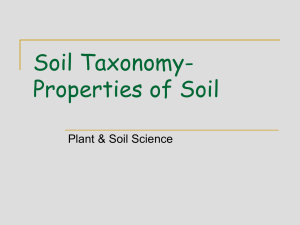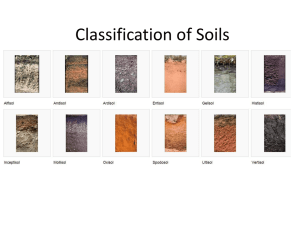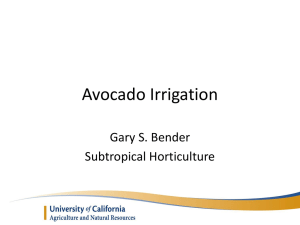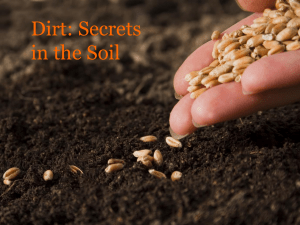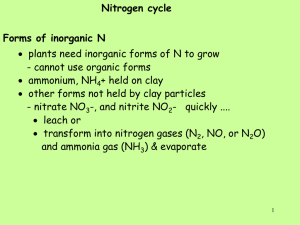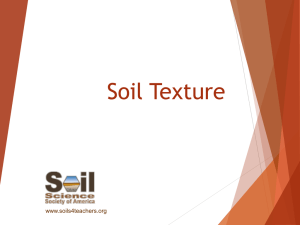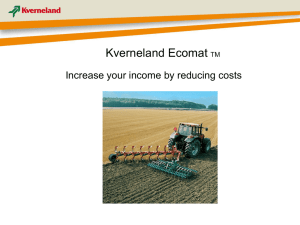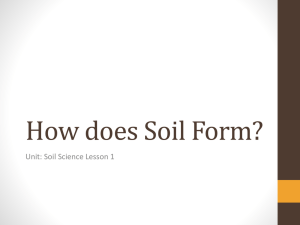12 Soil Orders - Department of Soil, Water, and Climate
advertisement
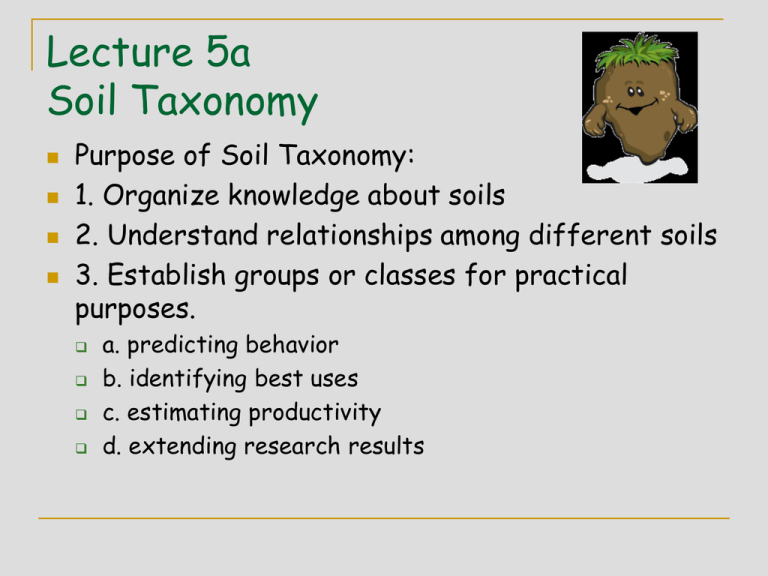
Lecture 5a Soil Taxonomy Purpose of Soil Taxonomy: 1. Organize knowledge about soils 2. Understand relationships among different soils 3. Establish groups or classes for practical purposes. a. predicting behavior b. identifying best uses c. estimating productivity d. extending research results Soil Taxonomy- 12 Soil Orders Soils are classified into into six categories based on diagnostic characteristics The last (largest) category will place the soils into one of the 12 Soil Orders. Soil Taxonomy Fine-loamy mixed, superactive, mesic Aquic Argiudolls (This is the name of a specific soil in Soil Taxonomy) 1) 2) 3) 4) 5) 6) Orders (12) Suborders (54) Great Groups (211) Subgroups (1,100+) Family (7,000+) Series (a lot!) This is the name of one Of the 12 large categories Mollisol - oll Oder - root of order Orders Fine-loamy mixed, superactive, mesic Aquic Argiudolls Highest and most general of the soil classification system (similar to the phylum in plant taxonomy) Based on conditions under which the soil developed Order oll = Mollisols Suborders Fine-loamy mixed, superactive, mesic Aquic Argiudolls Grouped by similarities in soil formation such as wetter/dryer soil, colder/warmer soil, etc. Sub Order Order Ud = Udic Moisture Great Groups (not required to know) Fine-loamy mixed, superactive, mesic Aquic Argiudolls Sub Order Great Group Based on differences between soil horizons Order Argi = Clay accumulation Sub Groups (not required to know) Fine-loamy mixed, superactive, mesic Aquic Argiudolls Describes a profile characteristic, wetness, sand, tonguing of E, etc. Sub Group Sub Order Great Order Group Aquic = wet soil Family (not required to know) Fine-loamy, mixed, superactive, mesic Aquic Argiudolls Family Texture, clay minerals, CEC, temp, Based on soil properties that affect management and root penetration, such as texture, temperature, and depth Sub Group Sub Order Great Group Order Series = Le Sueur – this is where the soils of the week names are from – ie Lester, Clarion, Nashwauk etc. Fine-loamy mixed, superactive, mesic Aquic Argiudolls Family Named from the town or landscape feature near where the soil was first recognized (Lester = Lester Prairie, MN. Other examples = Clarion, Nashwauk, Milaca, Port Byron, Zimmerman. Le Sueur for Le Sueur County, MN.) Sub Group Sub Order Great Group Order Diagnostics HorizonsUsed to place soils into one of the 12 Soil Orders Surface (Epipedon) Mollic Umbric Histic Ochric Subsurface • Argillic • Natric • Spodic • Oxic • Cambic • None Soil TaxonomyDiagnostic Surface Epipedons Mollic Epipedon - thick, dark, soft, surface layer. Characteristics Thick - greater than 10 inches; High base saturation> 50%; Mineral soil Soils formed under prairie vegetation Other Epipedons Umbric - like mollic, but low base saturation Histic - Organic Soil - saturated with water, > -% organic matter Ochric - thin, light colored surface layers that do not fit any of the above Base Saturation = relative amount of bases (Ca, Mg, K) in the soil, Low %= few, high% = many Comparison of Epipedons Ochric thinner Histic lighter color more organic matter Mollic low base saturation Umbric Diagnostic Subsurface Horizons Argillic - illuvial horizon of clay accumulation Bt Natric - same as argillic but with > 15% exchangeable sodium (Na) - Btn Diagnostic Subsurface Horizons Spodic - illuvial accumulation of oxides of Al and Fe (sesquioxides) and OM, red or dark red color - only found in acid sandy soils, with high rainfall- generally found below E horizon. Contains a Bhs or Bs horizon or Bhsm Oi E Bhs Bs C subsurface horizons (cont.) Oxic - very weathered layer of only Fe and Al oxides and 1:1 clay minerals, low pH and not very fertile (found in tropical soils) Bo Cambic - slightly altered layer - not weathered enough to be argillic, Bw horizon designation or development of color and or structure NONE - no diagnostic subsurface horizon present Comparison of Subsurface Diagnostic Horizons Spodic Cambic less developed more Al and Fe Argillic very weathered Oxic more sodium Natric 12 Soil Orders - Each Order has a diagnostic epipedon and subsurface horizons – which could be “none”. WEB SITE for soil orders = www.mines.uidaho.edu/pses/teach_res Entisol Inceptisol Andisols Spodosols Mollisols Alfisols Ultisols Oxisols Aridisols Vertisols Histosols Gelisols Entisol - ent Recent soils - minimal development, little horizonation, young 12.5% of world, Ochric + none soils. Entisol - Idaho A R Vertisol - ert Inverted - soils with high clay content, Large shrink swell potential gradually invert on themselves, 2.1% of the world, Mollic or Ochric + none - Vertisol = Bss at slickenslide Inceptisol - ept Inception - soil shows the beginning of horizon development, little or no illuviation, 15.8% of world, Ochric or Umbric + cambic. Inceptisol Soil Formed in colluvial material in mountains of Idaho. Aridisols - id Arid regions of the world (19%), < 10 in. rainfall, usually carbonates, Ochric + cambic or argillic or other diagnostic feature. of contain A Bw Bk C Aridisol in Idaho A Bt Bk Bkqm R Aridisol - Nevada NaCl Salt accumulates on the surface and in the subsurface. Az Bz C1 C2 Mollisols - oll soils with thick, dark, soft surface - mollic + natric, argillic high base - soils of the 9% of the world cambic, or none saturation prairie Mollisol This mollisol formed in a new parent material (loess) that buried the original soil -the Btb (b = buried). Mollisol from Kansas that is developed in Limestone bedrock. A1 A2 Bw BC R Spodosols- od acid sandy soils with thick E and red Bhs ochric and spodic 5.4 % of the world infertile soils. Oi E Bhs Bs C Alfisol -- alf fertile forested soils with saturation (> 35%) forested soils 7% of the world. ochric and argillic - high base Ultisols - ult soils more weathered than Alfisols - ochric and argillic - low base saturation < 35% - redder more acid than Alfisols 8.5% of the world - less than Alfisols A E and Bt1 Bt2 BC fertile Alfisol & Ultisol Histosols - ist peat soils - organic material - histic 0.8% of the world Histic Epipedon. Oe1 Oe2 Oe3 Oe4 Oa 2C Photo USDA Dyad Describe the Soil Order that is most likely found in your home town. Andisols - and soils from volcanic ash very light - low bulk density – 1% or the world A Bw Ab Bwb Ab’ Andisol from Idaho A Bw 2BC 2C Oxisols - ox Soils with Oxic horizon - very weathered soils of the tropics. low pH - acid soils high in 1:1 clay minerals 9.2% of world Oxisol Ap1 Ap2 Bo1 Bo2 Bo3 Oxisol Puerto Rico Ap A Bo1 Bo2 BC C Gelisol - el New Order as of 1998 - soils with permafrost (formerly Cryochrepts - or frozen Inceptisols) Cf - horizon Soil Orders USA Soil Orders in Minnesota Soil Orders – Wisconsin & Northern Illinois Soil Suborders of Minnesota Mollisol - Udoll - Boroll - Aquoll - Ustoll Alfisol -Udalf - Boralf - Aqualf Dropped in 1998 Entisol Orthent - Psamment – Aquent - Fluvent Inceptisol - Udept - Aquept Spodosol - Orthod Vertisol - Aquert Histosol - Fibrist - Hemist - Saprist Suborder definitions Ud - Udic moisture = moist -southern Mn type climate & Us = Ustic = Dry Bor - Boreas = northern Mn. Climate (Frigid Temperature regime) Aqu - Aquic moisture = saturated soil - high water table - Gleyed conditions Orth - true or simple - regular Entisols & Spodosols Psamm - sand - sandy Entisols Fluv - floodplain –irregular Organic matter Udoll - Ustoll - Aquoll Ustoll Udalf - Boralf - Aqualf Orthent - Psamment – Aquent Fluvent Orthent A Bw Not Cambic due to being too sandy C Fluvent – Soils of the floodplains. Lots of layers that are deposited when the river floods Orthod Minnesota Orthod Wisconsin Orthod A E Bhs Bs C Udept - Aquept EUTRUDEPTS Aquert Fibrist - Hemist - Saprist Suborder Map You need to know the location of the suborders in Minnesota
